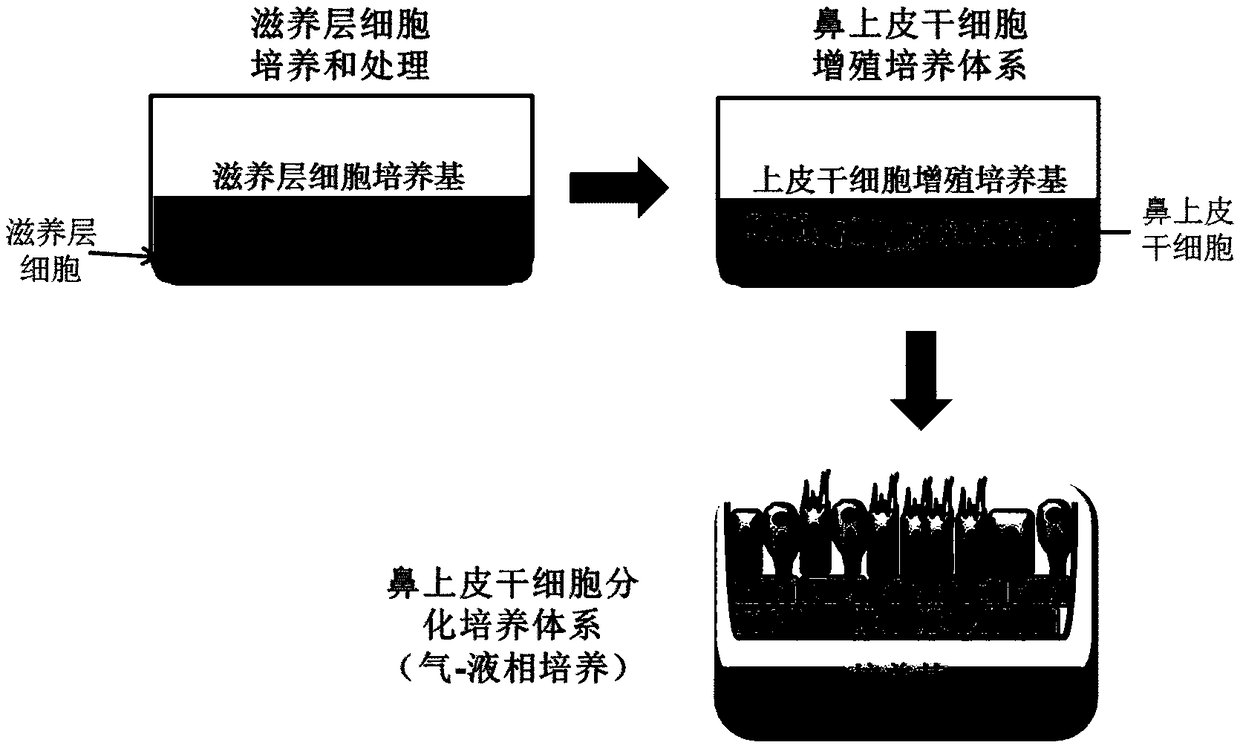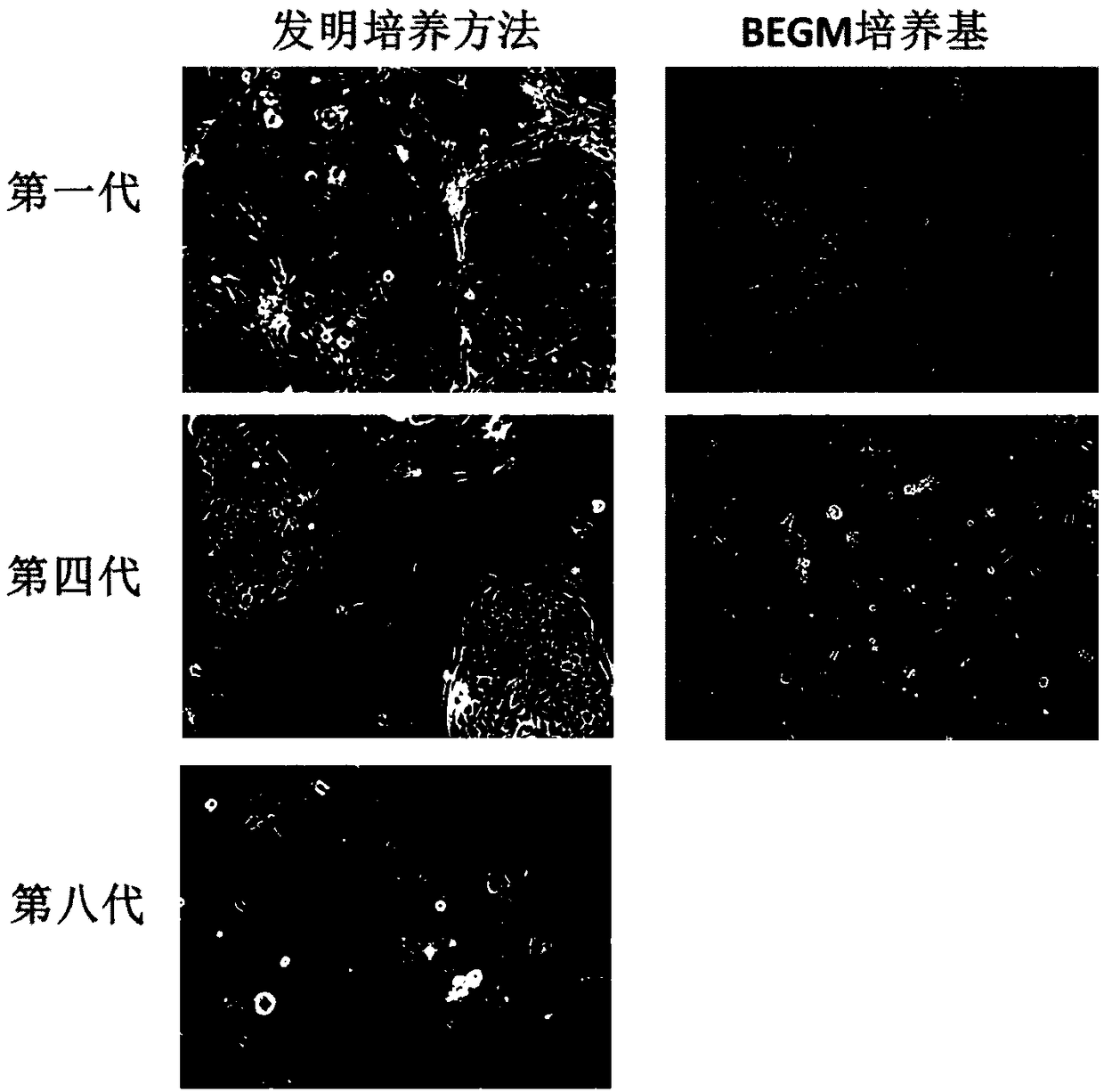Nose epithelial stem cell culture method and nose epithelial stem cell proliferation medium
A stem cell culture and stem cell proliferation technology, applied in the field of nasal epithelial stem cell culture method and nasal epithelial stem cell proliferation medium, can solve the problems that cells are difficult to differentiate into ciliated or goblet epithelial cells, the differentiation ability is reduced, and the differentiation ability is difficult to guarantee. Achieve the effect of maintaining proliferation ability, maintaining differentiation ability, and breaking through key technical bottlenecks
- Summary
- Abstract
- Description
- Claims
- Application Information
AI Technical Summary
Problems solved by technology
Method used
Image
Examples
Embodiment 1
[0093] Nasal epithelial stem cells were derived from sinusitis tissue samples from a patient diagnosed with chronic sinusitis.
[0094] 1) Treat trophoblast cells
[0095] ①The trophoblast cells were 3T3 cells, and the culture conditions were DMEM medium, 10% fetal bovine serum and 1x penicillin-streptomycin complex solution.
[0096] ②The 3T3 cells were grown to 100% density and treated with mitomycin to inhibit the growth of 3T3 cells. The concentration of mitomycin was 0.5-20ug / mL.
[0097] ③The trophoblast cells treated with mitomycin were digested according to a certain density (0.1-1x10 4 cells / cm 2 ) were pre-plated in cell culture dishes.
[0098] ④The 3T3 cells treated with mitomycin can adhere to the wall smoothly within 12 hours to 24 hours.
[0099] 2) Proliferation and cultivation of nasal epithelial stem cells (respectively used as the medium of the present invention and the BEGM medium)
[0100] ① After the trophoblast cells adhere to the wall, the epitheli...
Embodiment 2
[0125] Nasal epithelial stem cells were derived from nasal polyp tissue samples, and the patient was diagnosed with nasal polyps.
[0126] 1) Treat trophoblast cells
[0127] ①The trophoblast cells were 3T3 cells, and the culture conditions were DMEM medium, 10% fetal bovine serum and 1x penicillin-streptomycin complex solution.
[0128] ②The 3T3 cells were grown to 100% density and treated with mitomycin to inhibit the growth of 3T3 cells. The concentration of mitomycin was 0.5-20ug / mL.
[0129] ③The trophoblast cells treated with mitomycin were digested according to a certain density (0.1-1x10 4 cells / cm 2 ) were pre-plated in cell culture dishes.
[0130] ④The 3T3 cells treated with mitomycin can adhere to the wall smoothly within 12 hours to 24 hours.
[0131] 2) Proliferation and cultivation of nasal epithelial stem cells (respectively used as the medium of the present invention and the BEGM medium)
[0132] ① After the trophoblast cells adhere to the wall, the epith...
Embodiment 3
[0156] Nasal epithelial stem cells were derived from inferior turbinate tissue samples, and the patient was diagnosed with inferior turbinate hypertrophy.
[0157] 1) Treat trophoblast cells
[0158] ①The trophoblast cells were 3T3 cells, and the culture conditions were DMEM medium, 10% fetal bovine serum and 1x penicillin-streptomycin complex solution.
[0159] ②The 3T3 cells were grown to 100% density and treated with mitomycin to inhibit the growth of 3T3 cells. The concentration of mitomycin was 0.5-20ug / mL.
[0160] ③The trophoblast cells treated with mitomycin were digested according to a certain density (0.1-1x10 4 cells / cm 2 ) were pre-plated in cell culture dishes.
[0161] ④The 3T3 cells treated with mitomycin can adhere to the wall smoothly within 12 hours to 24 hours.
[0162] 2) Proliferation and cultivation of nasal epithelial stem cells (respectively used as the medium of the present invention and the BEGM medium)
[0163] ① After the trophoblast cells adhe...
PUM
 Login to View More
Login to View More Abstract
Description
Claims
Application Information
 Login to View More
Login to View More - R&D
- Intellectual Property
- Life Sciences
- Materials
- Tech Scout
- Unparalleled Data Quality
- Higher Quality Content
- 60% Fewer Hallucinations
Browse by: Latest US Patents, China's latest patents, Technical Efficacy Thesaurus, Application Domain, Technology Topic, Popular Technical Reports.
© 2025 PatSnap. All rights reserved.Legal|Privacy policy|Modern Slavery Act Transparency Statement|Sitemap|About US| Contact US: help@patsnap.com



